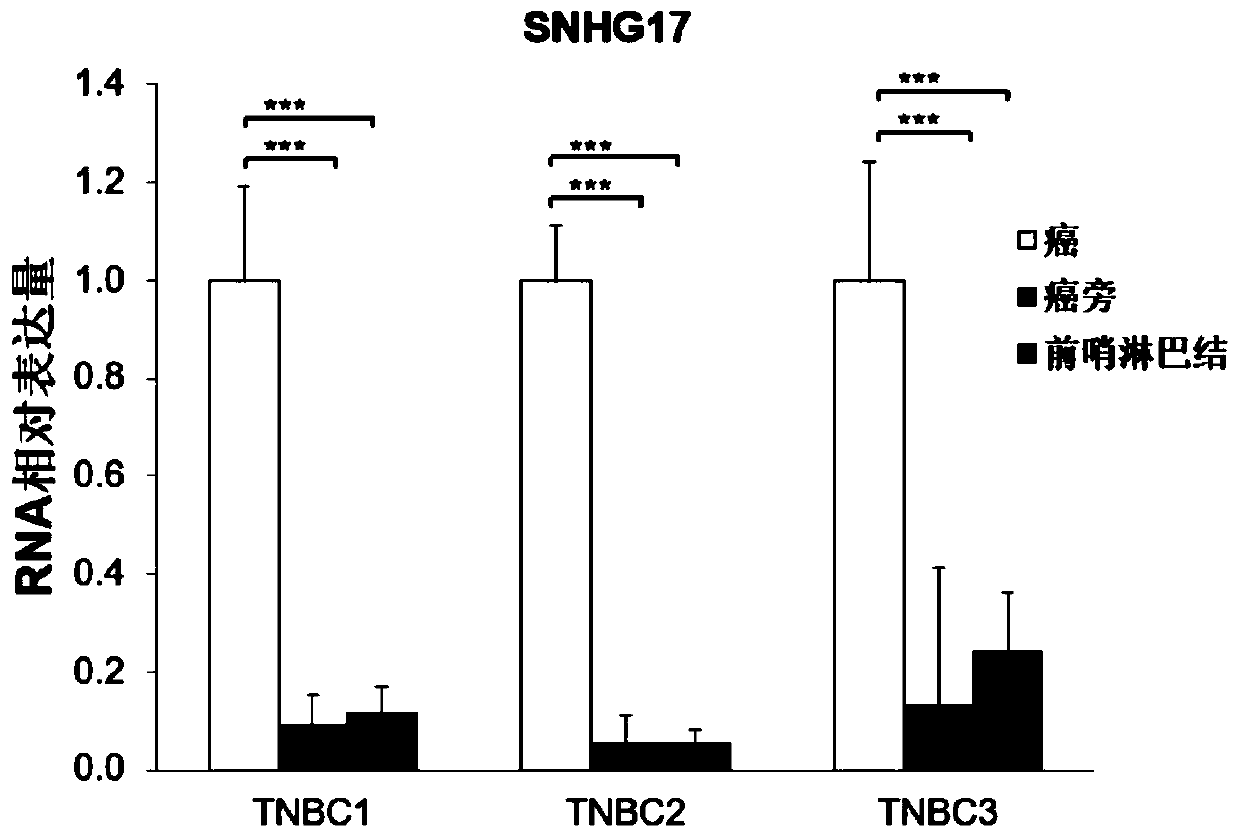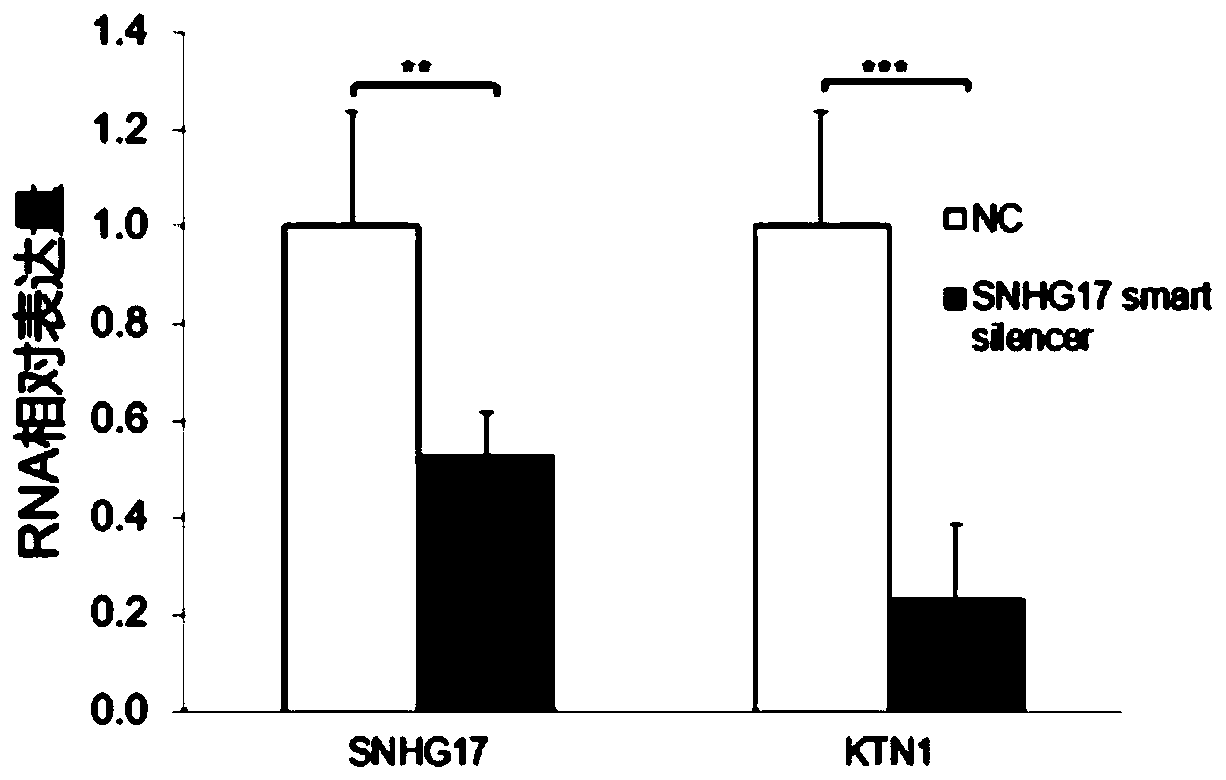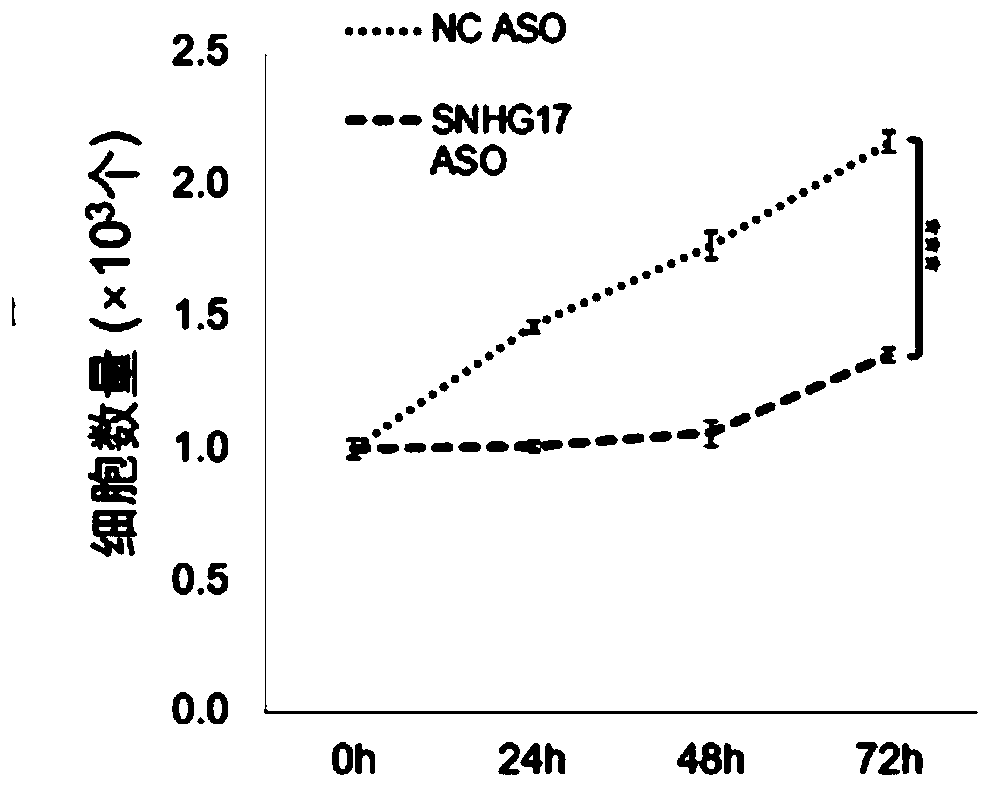Oligonucleotide targeting SNHG17 for treating breast cancer
An oligonucleotide and antisense oligonucleotide technology, applied in the field of oligonucleotides targeting SNHG17 in the treatment of breast cancer, can solve the problems of metastasis and recurrence, no effective target drugs, and treatment failure
- Summary
- Abstract
- Description
- Claims
- Application Information
AI Technical Summary
Problems solved by technology
Method used
Image
Examples
Embodiment 1
[0076] This embodiment relates to the impact of SNHG17RNA expression level in the tumor tissue of patients with triple negative breast cancer (TNBC):
[0077] The cancer tissue (Cancer), peritumorial tissue (Peritumorial) and sentinel lymph node tissue (Sentinel node) were collected from 3 groups of clinical TNBC patients, RNA was extracted respectively, and qRT-PCR was performed after reverse transcription. The results are as follows: figure 1 as shown ( figure 1 Among them, *p<0.05, **p<0.01, ***p<0.001), the expression of SNHG17RNA in TNBC tumor tissue was much higher than that in paracancerous tissue and sentinel lymph node tissue.
[0078] Conclusion: SNHG17 gene is related to the occurrence of TNBC.
Embodiment 2
[0080] This embodiment relates to the detection of antisense oligonucleotides' ability to regulate the proliferation of MDA-MB-231 and BT549 cells and the expression level of SNHG17 RNA in tumor tissues of TNBC patients.
[0081] NC ASO and SNHG17 ASO interference models were established in TNBC cell lines MDA-MB-231 and BT549 by the above-mentioned experimental method.
[0082] qRT-PCR method was used to detect the change of SNHG17RNA expression level of MDA-MB-231 cells transfected with NC ASO and SNHG17 ASO, specifically as follows figure 2 As shown, the SNHG17 RNA expression level of MDA-MB-231 cells transfected with SNHG17 ASO was much lower than that of the control group (NC ASO), and the SNHG17 ASO interference model was successfully established; image 3 After 0h, 24h, 48h and 72h of NCASO and SNHG17 ASO treatment of MDA-MB-231 cells, the changes in the proliferation of MDA-MB-231 cells after interference with SNHG17 were detected by the CCK8 method ( image 3 Among,...
Embodiment 3
[0086] This example involves detecting the effect of antisense oligonucleotides on the migration and invasion abilities of MDA-MB-231 and BT549 cells in tumor tissues of TNBC patients.
[0087] This example uses Transwell technology to detect the migration and invasion abilities of MDA-MB-231 and BT549 cells in the SNHG17 ASO interference model. The specific steps are:
[0088] NC ASO and SNHG17 ASO were transfected in MDA-MB-231 cells. After 48 hours of transfection, the treated MDA-MB-231 was transplanted in a Transwell chamber (the chamber for detecting invasion ability contained Matrigel), and 12- Collect cells at 16h and observe under a microscope, please refer to Figure 6 , Figure 7 and Figure 8 , Figure 6 Electron micrographs of cell migration and invasion after transfection of NC ASO and SNHG17 ASO in MDA-MB-231 cells for 48 hours, Figure 7 48h after transfecting MDA-MB-231 cells for NC ASO and SNHG17 ASO Figure 6 The cell number statistical diagram of the c...
PUM
 Login to View More
Login to View More Abstract
Description
Claims
Application Information
 Login to View More
Login to View More - R&D
- Intellectual Property
- Life Sciences
- Materials
- Tech Scout
- Unparalleled Data Quality
- Higher Quality Content
- 60% Fewer Hallucinations
Browse by: Latest US Patents, China's latest patents, Technical Efficacy Thesaurus, Application Domain, Technology Topic, Popular Technical Reports.
© 2025 PatSnap. All rights reserved.Legal|Privacy policy|Modern Slavery Act Transparency Statement|Sitemap|About US| Contact US: help@patsnap.com



